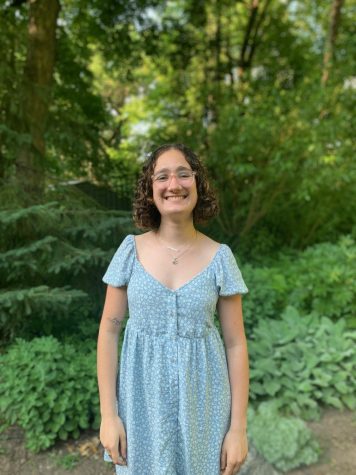Split of provost and dean of the faculty changes administrative organization
March 31, 2022
For the past thirty years, Macalester’s provost and dean of faculty have been combined into one position. Beginning this academic year, the two roles were split. The decision came after former Provost and Dean of Faculty Karine Moe stepped down from her position, ending her six-year tenure. This raised questions about the new division of labor between the two positions, as well as who should be a part of the tenure review process.
The decision followed a number of listening sessions among staff, students and faculty.
“With input from the campus, I agreed that it would be good to split those two [positions] apart,” President Suzanne Rivera said. “And it also created the opportunity for me to elevate the provost position and make it a provost and executive vice president.”
Before this semester, the provost and dean of faculty reported directly to the president. Now, the dean of faculty, along with the dean of students, reports to the provost.
During the listening sessions, one prevalent concern was that the combined role provost and dean of faculty included too many responsibilities.
“Over and over again, we heard this is too much for one person to do,” classics Professor and Faculty Advisory Committee (FAC) chair Beth Severy-Hoven said. “So the decision was made before somebody was hired into this job … to split it apart.”
Now, the dean of faculty directly oversees faculty affairs. Their responsibilities include faculty hiring, tenure promotion, faculty development and the process of reviewing academic departments every 10 years, among other things. Most importantly, they represent the faculty in the administration.
With these responsibilities off their plate, the provost is able to have a more holistic view of campus.
“Having [the dean of faculty] doing some more of the day-to-day faculty life stuff frees up the provost to kind of step back and see the campus as more of a whole,” Dean of the Faculty Tom Halverson said.
“The new purview means that I am thinking beyond academic affairs, and I’m trying to think about how [academic and student affairs] can work together … in ways that prioritize or center the student experience,” Executive Vice President and Provost Lisa Anderson-Levy said.
According to Rivera, the main motivation behind this split was to center student experience.
“Under that old arrangement, someone who worked in student affairs felt that … there was sort of a barrier to get over to work with people in the academic affairs line, and people in academic affairs felt like they couldn’t really comment on what was happening in the student affairs area,” Rivera said. “And that meant that occasionally things would fall through the cracks.”
Under the current organization, both the dean of faculty and the dean of students answer to the provost. Rivera says that this organization gives the provost a broader understanding of the student experience, without separating the academic aspect from others.
“Whether [students are] in the classroom, or they’re in Cafe Mac, or they’re on the soccer field, or they’re in the orchestra … it’s the same person,” Rivera said. “So how do we organize ourselves to make it more seamless and holistic?”
This change also started a debate around who should be involved in tenure decisions on the Faculty Personnel Committee (FPC). This committee, which handles tenure appointments, was traditionally made up of six faculty members, the president and the provost and dean of the faculty.
Now, because the provost and dean of the faculty are two positions, both serve. According to Halverson, faculty agreed that it made the most sense for the provost and dean of the faculty to sit on the FPC.
At the faculty meeting on Feb. 8, the faculty voted to remove the president from the FPC.
The measure passed with a clear majority of the faculty, was supported by Rivera and had unanimous approval from current FPC members.
“At the end of the day, the faculty voted to take the president off, not in a punitive way, but in a ‘this is not the best use of their time’ kind of way,” Anderson-Levy said.
Macalester was in the minority of institutions that have the president sit on the FPC, and so when the provost and dean of the faculty became two positions, it was a natural time to revisit the makeup of the committee. In addition to prioritizing the president’s time, the addition of another administrator to the FPC would have thrown off the balance between administrators and faculty.
“We were in the process of deciding who should be on [the FPC], who should make that decision,” Severy-Hoven said. “And now, the provost administrator became two people … that really increases the percentage of the committee that is administration as opposed to faculty.”
“It’s a faculty review process,” Anderson-Levy said. “And so that’s whose voices are prioritized.”
The president has sat on the FPC since the mid-1990s. According to John S. Hall Professor of environmental studies Dan Hornbach, then-Macalester President Bob Gavin thought that the president should serve on this committee to help ensure that the president was not always overturning the committee’s recommendations.
Severy-Hoven elaborated on this change, discussing its direct connection to Macalester’s rise in reputation during this time period.
“When Macalester, thirty-plus years ago, received a very large gift of money and began to have aspirations to attract students from across the country and across the world … part of attracting that is you have to have scholars that have a national and international reputation,” Severy-Hoven said. “And so the president, at the time, really did not want to grant tenure to professors who were not producing scholarship at the national and international level.”
With this desire, the president overturned a lot of the FPC’s tenure recommendations. As a result the president was added to the committee.
Under this model, the president was a part of the decision-making process on the committee, and also the appeals process. Now, the president is off the FPC, but still oversees the appeals processes.
“If there is a negative decision in a personnel review, the candidate can appeal the decision,” James Doyle, chair of the FPC and Professor of physics and astronomy, wrote in an email to The Mac Weekly. “Ultimately the President makes the final decision on the appeal. To have the President part of the original decision, then to have the President decide on the appeal, seems to be a clear conflict of interest.”
There is still discussion over the power of the president. At the most recent faculty meeting on March 8, a motion introduced proposed changes to the language in the faculty handbook that outlines the tenure review procedure. The proposed language states that the consensus of the FPC, dean of the faculty and the provost constitutes a recommendation to the president. Then the president will make the final decision and bring it to the board if they choose to recommend approving tenure.
The meeting ended before the faculty could vote on the motion as a whole, and so it will be on the agenda at the next faculty meeting in April.
The split of the provost and dean of the faculty positions have sparked discussions such as this one, demonstrating a complicated task of restructuring responsibilities.
“That conversation about the handbook … was an opportunity for folks to think about, ‘is this the best use of the president’s time?’” Anderson-Levy said. “What are the pros and cons? What’s the historical context about why the president at Macalester is put on there in the first place?”
The Mac Weekly will continue to report on the FPC changes as it develops and the new role of the president becomes more defined.
Estelle Timar-Wilcox and Lily Denehy contributed to the reporting for this story.














